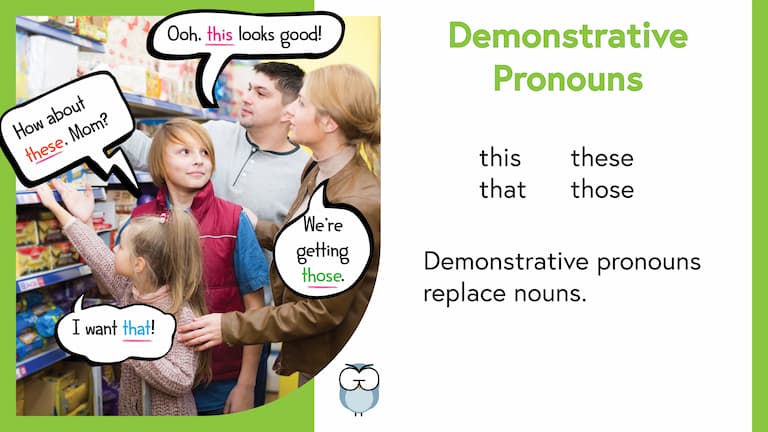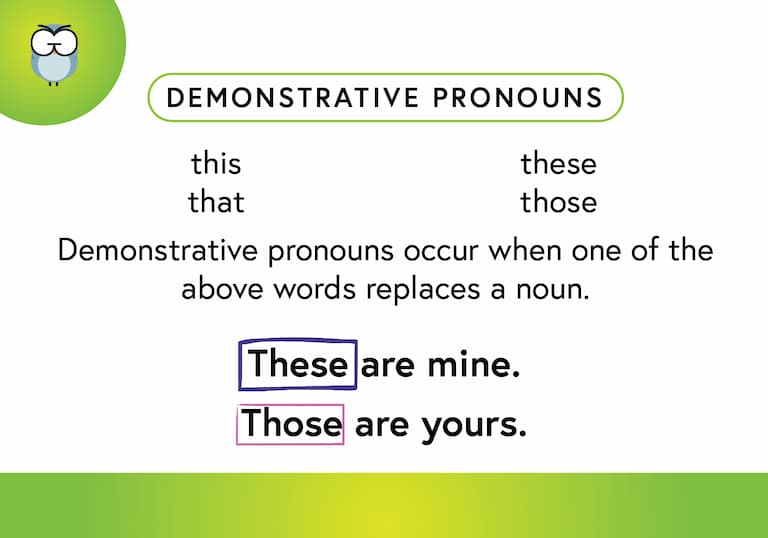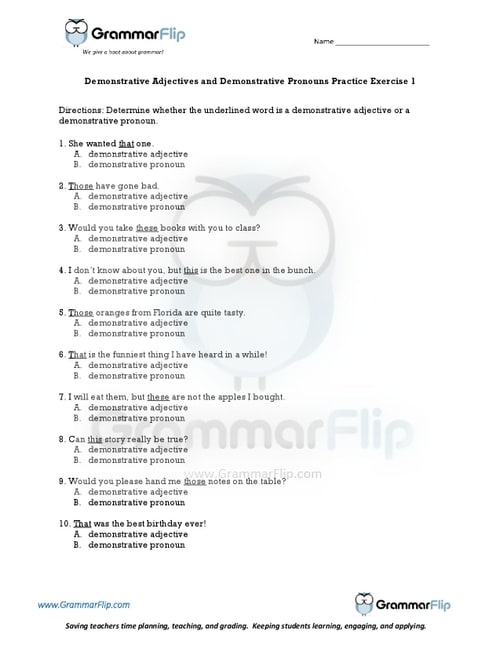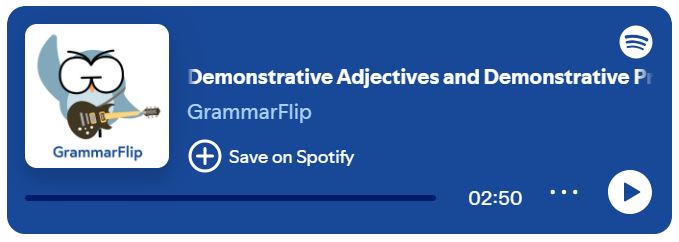What is a Demonstrative Pronoun?
A demonstrative pronoun can be one of four words: this, that, these, those. A demonstrative pronoun occurs when one of the above words is used to to take the place of a noun (either identified or unidentified).
Some examples of demonstrative pronouns would be the following:
Have you read this?
(notice “this” is an pronoun because it takes the place of another word)
Please hand me that. (notice “that” is an pronoun because it takes the place of another word)
Did you purchase these? (notice “these” is an pronoun because it takes the place of another word)
He wanted to bring those to the party. (notice “those” is an pronoun because it takes the place of another word)
Long-Form Video: Demonstrative Pronouns
Long-form instructional video lessons allow students to engage with grammar concepts in more depth and detail.
This format provides students with a stronger foundation and a more comprehensive understanding of demonstrative pronouns.
Short-Form Video: Demonstrative Pronouns
Short-form videos are an excellent way to review grammar concepts. Our two-minute instructional videos help students review the concept of demonstrative pronouns to further solidify their understanding.
Memorable Image: Demonstrative Pronouns

The use of images to connect visual cues with concepts makes it simpler for students to grasp and remember key ideas. GrammarFlip’s memorable images create visual associations that make demonstrative pronouns more engaging and easier to retain.
Definition Cards: Demonstrative Pronouns
Definition cards reinforce grammar concepts by providing clear and concise explanations that students can easily reference for quick review and better retention. GrammarFlip’s definintion cards help students review the concept of demonstrative pronouns to further solidify their understanding.

Music: Demonstrative Pronouns
Learn grammar concepts through music! The unique verses and catchy chorus in our “Demonstrative Adjectives and Demonstrative Pronouns Song” will help your students further understand demonstrative pronouns. Listen for yourself and see if you don’t walk away singing this song to yourself!
Listen to GrammarFlip Music via Spotify, Apple, or Amazon!
Music Videos: Demonstrative Pronouns
Music videos make grammar concepts more engaging and memorable by combining rhythm, visuals, and repetition to reinforce learning. GrammarFlip’s music videos help students retain the concept of demonstrative pronouns more effectively while making the learning process fun and interactive.
Why You Should Use Demonstrative Pronouns in Your Writing
Similar to demonstrative adjectives, demonstrative pronouns are used for clarification and emphasis, but a true primary use for demonstrative pronouns would be to avoid repetition in your writing.
Don’t use that; use this pencil instead.
Notice how the demonstrative “that” still refers to the pencil, and using “that” (demonstrative pronoun) instead of “that pencil” (demonstrative adjective) prevents the sentence from sounding repetitive.
Whether or not you choose to use a demonstrative pronoun or a demonstrative adjective in a given sentence will really depend upon your voice as a writer. Be sure to check out our GrammarFlip blog series on Voice in Writing.
Download a Free Worksheet on Demonstrative Pronouns!
Click the image below to download your free worksheet on demonstrative pronouns!

Need a grammar program that provides the instruction and grading for you?
Explore More GrammarFlip Lessons!
Parts of Speech lessons provide the building blocks of grammar. GrammarFlip covers these topics in detail to ensure a solid foundation is built. First time learners and students seeking to review the parts of speech can both benefit from the instructional videos and slide show reviews.
Parts of the Sentence lessons are critical for understanding how the parts of speech function in language construction. From the basic to the advanced, these lessons will cover a wide range of grammar topics that can be used in any grade level or classroom.
Mechanics and Usage lessons equip students with the necessary skills to communicate clearly to all audiences. With a focus on the application of these concepts in student writing, these lessons tie together both simple constructions of grammar as well as the more complex such that any age or skill level of student will benefit.


